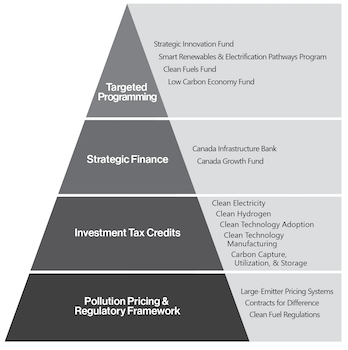Budget 2023’s post-secondary stand-out

In the wake of last week’s federal budget, much of the chatter surrounded topics like child care and a national dental program. At the heart of this document, however, was a major plank in the country’s industrial policy, emphasizing the importance of clean energy as an economic and environmental mainstay. For many Canadians, the research and innovation associated with that commitment are inextricably bound up with the country’s post-secondary educational institutions. Yet these merited just one mention, and perhaps not what some people were expecting.
It was, however, precisely what Denise Amyot had been hoping. As President and CEO of College and Institutes Canada (CICan), she represents the country’s diverse assortment of post-secondary educational institutions other than universities, including colleges, institutes of technology, or Quebec’s Collèges d'enseignement général et professionnel (CEGEPs). These were what found their way into the budget document.
“Canada’s colleges, CEGEPs, and polytechnic institutes use their facilities, equipment, and expertise to solve applied research problems every day,” it stated. “Students at these institutions are developing the skills they need to start good careers when they leave school, and by partnering with these institutions, businesses can access the talent and the tools they need to innovate and grow.”
Along with that endorsement, the budget committed $108.6 million to the Natural Sciences and Engineering Research Council’s College and Community Innovation program, which funds the interaction between businesses and CICan members. Amyot has spent the last few years ensuring the federal government was aware of what this program was accomplishing.
“We knew that they wanted to have results, and that is what we are all about,” she said, referring to data from 2020, when CICan members conducted some 6,400 research projects, yielding 5,500 new processes, products, or services. Of those results, some 85 percent were achieved within the year, as indicated by CICan's survey of its membership.
“Right now, what you need is to go at the pace of business,” Amyot explained. “We can find solutions for businesses in less than six months. That’s why the applied research we do is sought after. And we don’t even keep the IP — it stays with the company. Who would not want to partner with people like us?”
Seated in front of a map of Canada covered with dots Amyot points out just how well populated the landscape is with those people.
“There are 700 of those dots, and 95 percent of Canadians live within 50 km. of one of them, including 86 percent of Indigenous people.”
Each dot represents facilities such as a campus, college satellite location, or training centre, where individuals can acquire a broad range of professional and technical skills training and education, often as adult students returning to the classroom.
“It’s constantly adapting to the needs of industry, the needs of the community, and there’s no wrong door,” she said, noting that the average age of students is 27. “Anybody can access what we do in colleges. That’s why we have people who didn’t finish high school, as well as people who come from universities, who may or may not have a degree.”
As Amyot explained to Research Money, each of those dots could also serve local businesses with an interest in facilities or expertise found on a campus, usually as part of solving specific problems in manufacturing a product or providing a service. Such research projects may be very limited in scope, lasting only a few months, but they can be instrumental in helping smaller enterprises meet challenges that could otherwise be insurmountable. In the best case scenarios, such enterprises have a reason to stay in their community, where they boost local employment.
In this respect, although any specific college or institute might be relatively small in size, located in major urban settings or modest, out-of-the-way places, the cumulative impact of this expansive network — and its role in leveraging business support for research and innovation — has become increasingly significant. Just how significant, from CICan’s perspective, was confirmed by the federal budget.
“It is a recognition of the growing importance of applied research in our colleges,” concluded Amyot. “It means that the government values the expertise and the capabilities of our institutions.”
R$
| Organizations: | |
| People: | |
| Topics: |
Events For Leaders in
Science, Tech, Innovation, and Policy
Discuss and learn from those in the know at our virtual and in-person events.
See Upcoming Events
You have 0 free articles remaining.
Don't miss out - start your free trial today.
Start your FREE trial Already a member? Log in
By using this website, you agree to our use of cookies. We use cookies to provide you with a great experience and to help our website run effectively in accordance with our Privacy Policy and Terms of Service.





